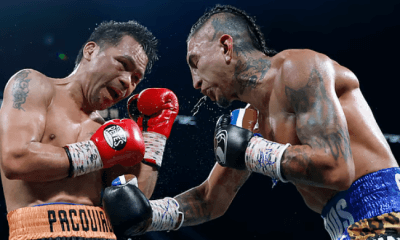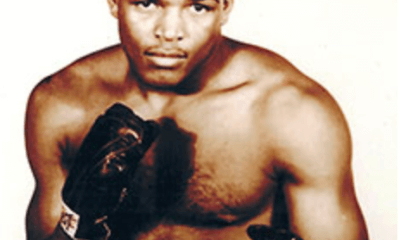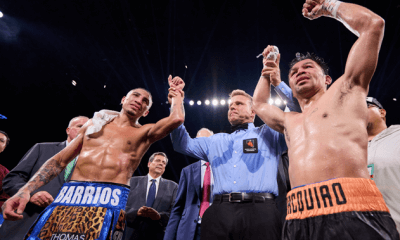Articles of 2006
Willie Smith – The Uncrowned World Champion
When making the television series “The Fighters” which covered 101 years of South African boxing history from 1889-1990, back in 1990, one of the biggest challenges was to find footage and stills to show while telling the history in chronological order. Needless to say I became very well acquainted with various archives, collectors, historians and media groups in the process. While I managed to uncover many gems in the quest, one which was perhaps the most exciting was finding an old nitrate film of the 1927 fight between South Africa’s Willie Smith and the UK’s Teddy Baldock.
Ironically had I not stumbled upon this treasure, that specific copy of the fight would have been lost forever. It was being kept in the garage of Willie Smith’s stepson along with a copy of one of his fights against Johnny Brown, the British and European bantamweight champion. Unfortunately the Brown footage was unsalvageable and had melted. We were however able to save 12 of the 15 rounds of the Smith-Baldock fight.
The fight which took place at the Albert Hall on October 6, 1927 was regarded in Britain as being for the bantamweight championship of the world. Baldock had defeated US fighter Archie Bell five months earlier and as the world title was vacant at the time, he was declared champion of the world in Britain, but not in the USA.
What a thrill it was to be able to watch on film a man described by many as one of the finest boxing talents the world has ever seen. The blue-eyed, curly haired Smith was the most popular boxer in South Africa in the 1920s.
While at the St. George’s home for orphans Smith became involved in amateur boxing and was noticed by Johnny Watson, a man who would earn a reputation of being one of the most decent men involved in local boxing. Smith’s father was killed in a mining accident and his mother, who had four children to care for, placed the two eldest boys in the orphanage. Watson taught Smith that intellect played a major role in the manly art and transformed the youngster from a vicious puncher into a master craftsman.
After winning the Olympic gold medal in 1924, Smith turned professional and quickly outclassed all opposition. In 1927 he outpointed Johnny Brown and served notice that he was ready to take on the best in the world. Following another impressive win over Ernie Jarvis, Smith left for Britain to challenge Teddy Baldock. He was a heavy underdog and few thought he would have any hope of defeating the “world champion.” Smith had other ideas however and displayed some of the finest scientific boxing ever seen in a British ring.
Smith’s fight plan against a taller, heavier and harder hitting opponent was calculated to the tee. He trapped Baldock into thinking that he was an open target for right-handers. Baldock forgot all about his left as he hunted with his big right hand. Whenever he threw it, however, Smith was nowhere to be found. Baldock would miss and Smith countered with perfectly delivered left hooks and sharp jabs – leaving Baldock looking somewhat of a novice.
An anonymous reporter on the weekly “Boxing, racing and Football” publication wrote, “Smith set his trap and Teddy stumbled into it. Willie would work round so obviously into the path of the left, yet was ever ready to sway away from its possible delivery that Teddy soon became suspicious. There was no guard up against a right, so Baldock would flash rights and Willie would not be there.”
Another first for me in watching the fight footage was that there was no referee in the ring. At that time in England, the referee would be seated outside the ring and would remain so unless things got out of hand and it was necessary for him to enter it. Although not a big puncher, Smith did drop Baldock. On this occasion you could see the referee standing up outside the ring and taking up the count.
Smith was incredible light on his feet and on the film seems to float around the ring with effortless ease. Smith won a lopsided points decision and was hailed in the British press as a master boxer and one of the greatest bantamweights the world has ever known. He was described as a greater natural boxer than even the great Jimmy Wilde knew how to be – in all respects save the ownership of a sleep producing punch. Probably the highest compliment one could receive in the British boxing world of the day.
While he was acknowledged as having won the world title in the UK, few others took the title claim seriously, yet 60 years later Herb Goldman, editor of The RING record book, decided that Smith’s win over Teddy Baldock had indeed earned him the bantamweight championship of the world.
Following his sensational win and with the world at his feet, Smith made a mistake, which would spell the end of his rise in International boxing. He signed a five-year contract, which bound him to an American who had strong underworld connections. Showing the extent of respect Smith enjoyed, he was also offered a contract by Billy Gibson, manager of Gene Tunney. Thinking he was bound by what turned out to be an illegal contract Smith turned Gibson down and with that probably any hope of successfully breaking into the US market.
In later years Smith told the late Chris Greyvenstein, the greatest boxing writer to ever come out of South Africa, “I was taken to the gang’s headquarters in a large flat in 57th Street, New York. It amused me at the time to see just opposite the flat was the headquarters of the New York motor police, and armoured side-cars with machine-guns and protective screens for the driver, were all round the vicinity. But if the gang ever got into trouble, I never saw any of it. I did not allow that friendship to develop.” Smith had one fight in the US under his management team, which he lost and then left the country.
Smith did continue fighting and put on some great displays of his fistic abilities including a controversial points loss in Australia against former flyweight world champion Fidel La Barba in Australia. The Sydney crowd erupted in a riot following the decision and a rematch was made a month later; it was Smith's third fight in three months Down Under. This time La Barba stopped Smith in the 12th round of the fight. Smith’s immense popularity in South Africa remained throughout his career and many ascribe it to seeing the Smith-Baldock fight screened in local cinemas. Amongst his most publicised performances in South Africa were his rearguard actions against the hard-hitting American Micky Doyle, and his victories over the likes of Ginger Jones, Cecil Como and Ernest Wohrer. After retiring in 1936, Smith became a highly respected referee and later tragically died at the age of 51 of a heart attack on December 22, 1955.
He was a remarkable talent who, while adored by local fight fans, never received the full International recognition he deserved while he was alive. It must have left a bittersweet taste in the mouth, winning a world championship fight, but not the title of world champion.
-

 Featured Articles3 weeks ago
Featured Articles3 weeks agoResults and Recaps from New York Where Taylor Edged Serrano Once Again
-

 Featured Articles1 week ago
Featured Articles1 week agoThe Hauser Report: Zayas-Garcia, Pacquiao, Usyk, and the NYSAC
-

 Featured Articles2 days ago
Featured Articles2 days agoOscar Duarte and Regis Prograis Prevail on an Action-Packed Fight Card in Chicago
-

 Featured Articles3 weeks ago
Featured Articles3 weeks agoResults and Recaps from NYC where Hamzah Sheeraz was Spectacular
-

 Featured Articles4 weeks ago
Featured Articles4 weeks agoFrom a Sympathetic Figure to a Pariah: The Travails of Julio Cesar Chavez Jr
-

 Featured Articles2 weeks ago
Featured Articles2 weeks agoManny Pacquiao and Mario Barrios Fight to a Draw; Fundora stops Tim Tszyu
-

 Featured Articles3 weeks ago
Featured Articles3 weeks agoPhiladelphia Welterweight Gil Turner, a Phenom, Now Rests in an Unmarked Grave
-

 Featured Articles2 weeks ago
Featured Articles2 weeks agoArne’s Almanac: Pacquiao-Barrios Redux
















